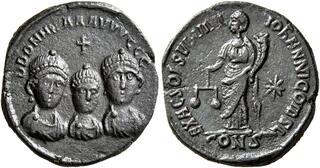| Leu Numismatik AG > Auction 15 | Auction date: 1 June 2024 |
| Lot number: 319 Price realized: This lot is for sale in an upcoming auction - Bid on this lot  | Show similar lots on CoinArchives Find similar lots in upcoming auctions on |
| Lot description: Arcadius, with Honorius and Theodosius II, 383-408. Exagium Solidi (Bronze, 21 mm, 4.13 g, 6 h), Constantonopolis. Johannes, comes sacrarum largitionum, 403-404. DDD NNN AAAVVVGGG Diademed and draped facing busts of Arcadius, on the left, and Honorius, on the right; in the center, diademed and draped facing bust of Theodosius II, smaller and with cross above. Rev. EXAG SOL SVB V INL - IOhANNI COm S L / CONS Moneta standing front, head to left, holding scales in her right hand and cornucopiae in her left; to right, star. Bendall 9. Göbl, Antike Numismatik, 229. MAH 411. Very rare and of great historical interest. An exceptionally well preserved example of this intriguing weight. Slightly smoothed and repatinated, otherwise, about extremely fine. From a European collection, formed before 2005. The reverse legend of this highly intriguing weight is to be deciphered as exagium solidi sub viro inlustri Iohanni comite sacrarum largitionum, translating to 'test weight of a solidus under the illustrious Johannes, Count of the Sacred Largesses.' As comes sacrarum largitionum, Johannes held the role akin to a finance minister for state expenditures, while the comes sacrarum rerum privatarum managed the emperor's private treasury. However, the delineation of responsibilities was not always clear-cut, just as the distinction between 'state' and 'private' could be fluid. Among Johannes' primary tasks were tax collection, disbursing donatives to soldiers, and overseeing imperial gifts. Moreover, he was responsible for the imperial mints, which explains why his name appears on our exagium - through the issuing of coin weights for the solidus, the empire's leading denomination, Johannes, by the authority of his office, ensured that no underweight solidi circulated and, notably, that no one paid their taxes in clipped solidi. Fortunately, we can securely pinpoint Johannes's tenure as comes sacrarum largitionum, as he is attested in that role in the years 403-404 (PLRE II, 593-594). Furthermore, Johannes is historiographically attested as being a protégé of Empress Aelia Eudoxia, according to Synesius of Cyrene and Zosimus. Both authors also mention rumors suggesting that John might have been the illegitimate father of Theodosius II (401-450). Synesius expresses his surprise that this hearsay about a relationship between John and the empress did not harm his position at court. It is difficult to ascertain whether these rumors merely reflect typical chatter about the imperial court, but they undeniably underscore John's considerable influence, which likely waned only with the death of his imperial patron on 6 October 404. Estimate: 1500 CHF |  |



